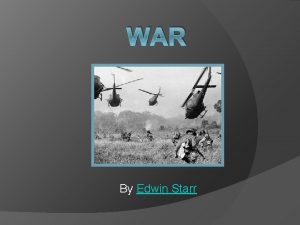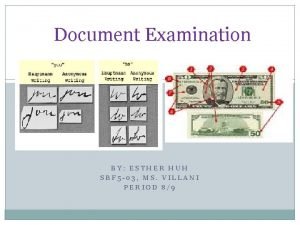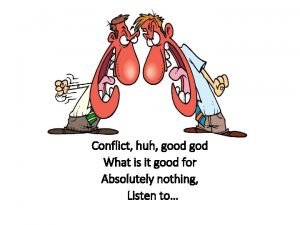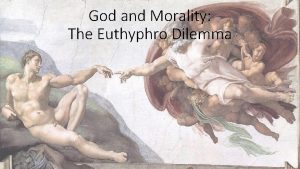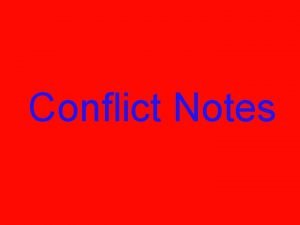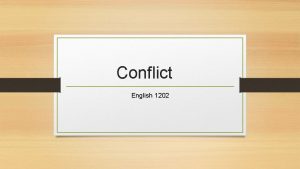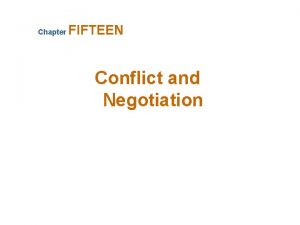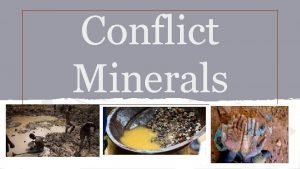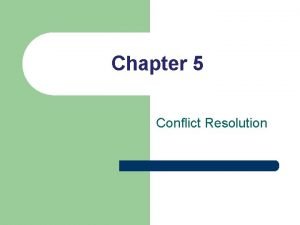Conflict huh good god What is it good





























- Slides: 29

Conflict, huh, good god What is it good for Absolutely nothing, Listen to…

…smoke alarms? ? ? Similar function as office conflict. Don’t ignore it, Embrace it!

Why is my smoke alarm chirping ? 1. Sarcasm…. Nip it in the bud 2. Being tougher on “submissive” employees 3. Having all the answers (o. k. to be humble) 4. Forced laugher (i. e. chuckle) before spouting wisdom 5. Others? ?

Smoke Detector Fact? or Myth? 1. Conflict is always a negative and should be avoided. 2. Difficult people are almost always the cause of conflict. 3. The problem at the root of a conflict is usually obvious. 4. In conflict, there always winners and losers. 5. It’s a supervisor’s responsibility to fix problems on the team.

Listening to Staff q. Ask questions. When the other person has finished talking, instead of replying, ask yourself this question, “What did I hear being said? ” q Ask better questions. To engage in a conversation, nothing is more important than your choice in questions. Asking the wrong question causes people to defend their position. Asking right questions decreases resistance. 1. Begin with "What" or "How" (not "Why, " "When, " or Who"). 2. Contain an "I" (not "they, " "them, " "we" or "you"). 3. Focus on action.

Examples (QBQ): • "What can I do to help you do your job better? " • "What can I do to make a difference? " • "How can I support the team? " • "How can I help move this forward? " • "How can I provide value to you? " • "What solution can I provide? " • "How can I do my job better today? " • "How can I improve the situation? " • "How can I better understand you? " • "What can I do to find the information to make a decision? "

Understanding Staff Understanding and managing different personalities in the workplace is important for your office culture, productivity and team effectiveness (and your sanity).

Eagles Strength Assertive Direct Confident Risk-Taking Results-driven Overuse Aggressive Blunt Arrogant Reckless Short-sighted

Eagles q Controller wants facts and little details q Can be perceived as bossy and insensitive q Major motivation is to get things done. q Will take a project and run with it, often no plan, “figure it out as they go. ”

Eagles q Needs to feel respected q. Talk in terms of results (e. g. solutions not problems) q. Remind them how much more will be achieved if coworkers are treated in a healthy way q. Give conclusions and only provide details if asked. Get to the point.

Peacocks Strength Visionary Multi-tasker Persuasive Optimistic Enthusiastic Overuse Unrealistic Disorganized Manipulative Impractical Self-promoting

Peacock (Parrots) q. The Promoter in the office q Life of the party, love people and love to talk q. Natural sociability allows them to talk for long periods of time about almost anything q. Have an attractive personality, are enthusiastic, curious and expressive q. Give them a spotlight so won’t be compelled to steal one.

Peacock (Parrots) q Leave plenty of time for talk & social issues. q Ask them about their family, children, pets… q Talk in terms of people and stories. q Use lots of examples q Require positive feedback to focus energy on something productive.

Doves Strength Collaborative Patient Cautious Tolerant Trusting Overuse Dependent Complacent Fearful Permissive Naïve

Doves q Supporter communication style is typically low key, calm, cool, collected and patient q Typically competent and steady workers q Do not like to be involved in conflict q When there is conflict may be called upon to mediate the problem q. Good listeners and usually have many friends and avoid offending people

Dove q Don’t come on too strong. q Earn trust in small steps. q Don’t ask for big decisions right away. q Provide plenty of reassurance. q Talk in terms of security. q Self-worth from service to other. Takes on unnecessary burdens. If sacrifice is not recognized, will suffer in silence as The Martyr. Instead of asking for help, become passive aggressive. q. Appreciate them for their unsung work.

Owls Strength Analytical Discerning Process-oriented Focused Careful Overuse Indecisive Judgmental Bureaucratic Detached Picky

Owl q Are “facts and figures” people q Love details and to organize things. Tend to be deep, thoughtful, analytical, serious q. Communication style includes a need for details, sometimes hesitate to make decisions if they feel that they don’t have enough facts q. Love lists, charts, graphs and figures q Pay so much attention to details, they can sometime be seen as being pessimistic

Owls q. Owls gone overboard become The Critic. Unpleasable, distrusting, killjoy q. Shoots down new ideas and processes q No one else’s work merits trust or appreciation q. Lost control over quality. Heard information too late. Left out of loop.

Owl q. Make sure your are well prepared. q. Have plenty of facts and figures. q. Be prepared for skepticism. q. Answer all of their questions. q. Go relatively slow to give them time to think and analyze. q. Counsel them to seek excellence not perfection.

Vampires q. Disengaged Eagles, Parrots, Doves or Owls become Vampires. See worst in everything. q Dampen spirit in healthy coworkers. q Don’t want to be at work. q Their apathy is contagious. WASTE NO TIME. It will affect others. Plus zaps your energy. q Manageable when you help them understand source of dysfunction and capitalize on natural gifts

Turning Conflict into a Cause for Commitment

Five Conflict Management Strategies üConfront problems with head on, not headon. ü Be a truth seeker. üRehearse your emergency landing, descent and approach (i. e. write a script). üTalk on the employee’s “turf”. üStick to behavior…never the person’s character.

Five Coaching Strategies üReign in your emotions üGive your employees some latitude üShow them what went wrong üDo not point fingers (responsible vs. wrong) üEnd by looking ahead (shift focus from failure to success)

Find a Common Purpose Look Forward in Times of Rapid Change v. Being a leader, you must be able to envision the future. The speed of change doesn’t alter this fundamental truth. v. People want to follow those who can see beyond today’s problems, conflicts and visualize a brighter tomorrow.

Appeal To Common Ideas v. Connect to what’s meaningful to others “You can make more friends in two months by becoming interested in other people than you can in two years by trying to get other people interested in you. ” - Dale Carnegie, How to Win Friends and Influence People

Presence, Affirmation, Promise v Goal is to keep everyone focused on looking for opportunities for improvement. v. Recognize different office factions exist (remain objective and not be sidetracked by conflicts). v Be sensitive to staff’s needs (each one is motivated by different hierarchy of needs). HINT…I never heard a complaint from staff about being affirmed too much. v Encourage factions to discuss differences (set a time limit to resolve disagreements quickly).

Animate Your Vision “You've got to know when to hold 'em Know when to fold 'em Know when to walk away And know when to run You never count your money When you're sittin' at the table There'll be time enough for countin' When the dealin's done” “The Gambler” by Kenny Rogers

Wayne Gillam Wayne. Gillam@vr. dese. mo. gov 573 -522 -6338
 Huh what is it good for absolutely nothing
Huh what is it good for absolutely nothing Esther huh
Esther huh Huh microguide
Huh microguide Nn_robot
Nn_robot God is good god is great speed
God is good god is great speed Internal conflict meaning
Internal conflict meaning What is conflict and conflict resolution?
What is conflict and conflict resolution? External and internal conflict definition
External and internal conflict definition Google
Google Good evening hi
Good evening hi Hello good afternoon teacher
Hello good afternoon teacher Nothing compares to your embrace
Nothing compares to your embrace Good evening students
Good evening students Our god is an awesome god vine
Our god is an awesome god vine My god is an awesome god he reigns
My god is an awesome god he reigns Awesome god medley
Awesome god medley O god you are my god earnestly i seek you
O god you are my god earnestly i seek you God-given virtues that direct us to our loving, triune god.
God-given virtues that direct us to our loving, triune god. God-given virtues that direct us to our loving, triune god.
God-given virtues that direct us to our loving, triune god. My god's bigger than your god
My god's bigger than your god God is too good to be unkind
God is too good to be unkind Divine command theory and euthyphro dilemma
Divine command theory and euthyphro dilemma God you are good and your mercy endureth forever
God you are good and your mercy endureth forever God saw everything
God saw everything Good samaritan acts of kindness
Good samaritan acts of kindness Everything works for good
Everything works for good God is good all the time verse
God is good all the time verse God is good all the time in korean
God is good all the time in korean Good morning, ladies and gentlemen. could i have your
Good morning, ladies and gentlemen. could i have your Excellent very good good fair poor scale
Excellent very good good fair poor scale
